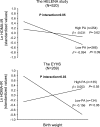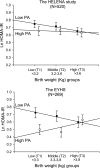Physical activity attenuates the effect of low birth weight on insulin resistance in adolescents: findings from two observational studies
- PMID: 21752955
- PMCID: PMC3161315
- DOI: 10.2337/db10-1670
Physical activity attenuates the effect of low birth weight on insulin resistance in adolescents: findings from two observational studies
Abstract
Objective: To examine whether physical activity influences the association between birth weight and insulin resistance in adolescents.
Research design and methods: The study comprised adolescents who participated in two cross-sectional studies: the Healthy Lifestyle in Europe by Nutrition in Adolescence (HELENA) study (n = 520, mean age = 14.6 years) and the Swedish part of the European Youth Heart Study (EYHS) (n = 269, mean age = 15.6 years). Participants had valid data on birth weight (parental recall), BMI, sexual maturation, maternal education, breastfeeding, physical activity (accelerometry, counts/minute), fasting glucose, and insulin. Insulin resistance was assessed by homeostasis model assessment-insulin resistance (HOMA-IR). Maternal education level and breastfeeding duration were reported by the mothers.
Results: There was a significant interaction of physical activity in the association between birth weight and HOMA-IR (logarithmically transformed) in both the HELENA study and the EYHS (P = 0.05 and P = 0.03, respectively), after adjusting for sex, age, sexual maturation, BMI, maternal education level, and breastfeeding duration. Stratified analyses by physical activity levels (below/above median) showed a borderline inverse association between birth weight and HOMA-IR in the low-active group (standardized β = -0.094, P = 0.09, and standardized β = -0.156, P = 0.06, for HELENA and EYHS, respectively), whereas no evidence of association was found in the high-active group (standardized β = -0.031, P = 0.62, and standardized β = 0.053, P = 0.55, for HELENA and EYHS, respectively).
Conclusions: Higher levels of physical activity may attenuate the adverse effects of low birth weight on insulin sensitivity in adolescents. More observational data, from larger and more powerful studies, are required to test these findings.
Figures


Similar articles
-
More physically active and leaner adolescents have higher energy intake.J Pediatr. 2014 Jan;164(1):159-166.e2. doi: 10.1016/j.jpeds.2013.08.034. Epub 2013 Oct 3. J Pediatr. 2014. PMID: 24094763
-
Dietary and lifestyle quality indices with/without physical activity and markers of insulin resistance in European adolescents: the HELENA study.Br J Nutr. 2013 Nov;110(10):1919-25. doi: 10.1017/S0007114513001153. Epub 2013 Apr 19. Br J Nutr. 2013. PMID: 23596986
-
Daily sugar-sweetened beverage consumption and insulin resistance in European adolescents: the HELENA (Healthy Lifestyle in Europe by Nutrition in Adolescence) Study.Public Health Nutr. 2013 Mar;16(3):479-86. doi: 10.1017/S1368980012002613. Epub 2012 Sep 25. Public Health Nutr. 2013. PMID: 23009737 Free PMC article.
-
Early life programming of attention capacity in adolescents: The HELENA study.Matern Child Nutr. 2018 Jan;14(1):e12451. doi: 10.1111/mcn.12451. Epub 2017 Apr 11. Matern Child Nutr. 2018. PMID: 28401662 Free PMC article.
-
Sleep efficiency as a determinant of insulin sensitivity in overweight and obese adolescents.Diabetes Obes Metab. 2015 Sep;17 Suppl 1:90-8. doi: 10.1111/dom.12515. Diabetes Obes Metab. 2015. PMID: 26332973 Review.
Cited by
-
Overcoming birth weight: can physical activity mitigate birth weight-related differences in adiposity?Pediatr Obes. 2016 Jun;11(3):166-73. doi: 10.1111/ijpo.12040. Epub 2015 May 19. Pediatr Obes. 2016. PMID: 25988588 Free PMC article.
-
From fatalism to mitigation: A conceptual framework for mitigating fetal programming of chronic disease by maternal obesity.Prev Med. 2015 Dec;81:451-9. doi: 10.1016/j.ypmed.2015.10.012. Epub 2015 Oct 30. Prev Med. 2015. PMID: 26522092 Free PMC article. Review.
-
Developmental Programming of Body Composition: Update on Evidence and Mechanisms.Curr Diab Rep. 2019 Jul 20;19(8):60. doi: 10.1007/s11892-019-1170-1. Curr Diab Rep. 2019. PMID: 31327060 Review.
-
Higher fetal insulin resistance in Chinese pregnant women with gestational diabetes mellitus and correlation with maternal insulin resistance.PLoS One. 2013;8(4):e59845. doi: 10.1371/journal.pone.0059845. Epub 2013 Apr 1. PLoS One. 2013. PMID: 23560057 Free PMC article.
-
Prenatal Development and Adolescent Obesity: Two Distinct Pathways to Diabetes in Adulthood.Child Obes. 2018 Apr;14(3):173-181. doi: 10.1089/chi.2017.0290. Epub 2018 Apr 6. Child Obes. 2018. PMID: 29624412 Free PMC article.
References
-
- Lawlor DA, Riddoch CJ, Page AS, et al. The association of birthweight and contemporary size with insulin resistance among children from Estonia and Denmark: findings from the European Youth Heart Study. Diabet Med 2005;22:921–930 - PubMed
-
- Whincup PH, Kaye SJ, Owen CG, et al. Birth weight and risk of type 2 diabetes: a systematic review. JAMA 2008;300:2886–2897 - PubMed
-
- Ludwig DS, Ebbeling CB. Type 2 diabetes mellitus in children: primary care and public health considerations. JAMA 2001;286:1427–1430 - PubMed
-
- Rizzo NS, Ruiz JR, Oja L, Veidebaum T, Sjöström M. Associations between physical activity, body fat, and insulin resistance (homeostasis model assessment) in adolescents: the European Youth Heart Study. Am J Clin Nutr 2008;87:586–592 - PubMed

